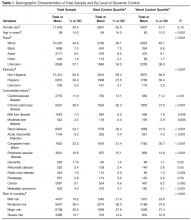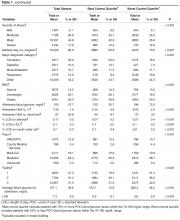Glycemic Control (Independent Variable)
Glycemic control was defined as POC blood glucose values within the target range of 70 to 180 mg/dL during hospitalization. POC tests outside that range were defined as SGC. This range was determined based on current Sharp benchmark targets and was not adjusted for total number of blood glucose values.
Predictive Variables
A framework for potentially relevant patient and clinical care factors associated with suboptimal glycemic control was developed based on literature review and input from Sharp clinical experts. Administrative and clinical patient characteristics, including patient demographic, clinical status and care process factors were operationalized into 32 variables that were extracted from Sharp’s data warehouse (see Table 1 ). The majority of variables were selected to be identifiable on or shortly after admission, although operationalization of some variables in this study was done with administrative rather than clinical data. Steroid use and ICU stay were operationalized for the entire admission because of clinician interest: while it is generally known fairly soon after admission whether a patient will be admitted to an ICU or if steroids will be administered, the study question from the clinician standpoint was not so much if steroids or ICU stay predicted SGC but how much ICU or steroid use was predictive. Diabetes management was operationalized for the entire admission and included as a covariate to account for lack of glycemic management as a cause of suboptimal glycemic control. Other variables, such as patient LOS and mean blood glucose for admission were extracted for descriptive purposes only and not included in the model.Age, gender, race, ethnicity, payor, facility and LOS were extracted from Sharp’s data warehouse. Medical vs. surgical stay and major diagnostic category was determined from administrative diagnosis coding. Body mass index (BMI) was extracted from Sharp’s electronic health record. Risk of mortality and severity of illness were calculated using 3M APR-DRG proprietary software using administrative diagnosis coding. Comorbidities were determined based on administrative diagnosis codes per published guidelines [11]. Glycosylated hemoglobin (HbA1c) was obtained on admission for patients with a secondary diagnosis of diabetes as part of Sharp's multidisciplinary diabetes care management program and extracted from the electronic health record. Admission blood glucose was defined as the first documented POC blood glucose after admission. ICU stay was calculated as a continuous variable: the percent of LOS spent in the ICU. Steroid use was similarly calculated, and defined as oral or intravenous administration of any quantity or dosage of the following corticosteroids during each day of hospitalization: dexamethasone, hydrocortisone, prednisone, and/or methylprednisone. Adherence to Sharp's multidisciplinary diabetes care management program was measured by use of standardized insulin order sets. Sharp uses evidence-based order sets for continuous infusion and subcutaneous insulin management; subcutaneous orders include basal and rapid-acting insulin. We calculated the total time a person was on an order set during hospitalization by subtracting any time a patient did not have insulin ordered from the total LOS. This was transformed into a variable documenting the percent of LOS the patient was on an insulin order set. Average blood glucose for admission was calculated for all documented POC blood glucoses during admission, omitting the admission blood glucose (the first POC blood glucose of the admission).


